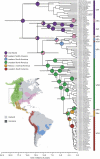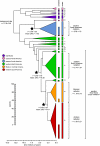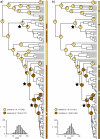Multiple continental radiations and correlates of diversification in Lupinus (Leguminosae): testing for key innovation with incomplete taxon sampling - PubMed (original) (raw)
Multiple continental radiations and correlates of diversification in Lupinus (Leguminosae): testing for key innovation with incomplete taxon sampling
Christopher S Drummond et al. Syst Biol. 2012 May.
Abstract
Replicate radiations provide powerful comparative systems to address questions about the interplay between opportunity and innovation in driving episodes of diversification and the factors limiting their subsequent progression. However, such systems have been rarely documented at intercontinental scales. Here, we evaluate the hypothesis of multiple radiations in the genus Lupinus (Leguminosae), which exhibits some of the highest known rates of net diversification in plants. Given that incomplete taxon sampling, background extinction, and lineage-specific variation in diversification rates can confound macroevolutionary inferences regarding the timing and mechanisms of cladogenesis, we used Bayesian relaxed clock phylogenetic analyses as well as MEDUSA and BiSSE birth-death likelihood models of diversification, to evaluate the evolutionary patterns of lineage accumulation in Lupinus. We identified 3 significant shifts to increased rates of net diversification (r) relative to background levels in the genus (r = 0.18-0.48 lineages/myr). The primary shift occurred approximately 4.6 Ma (r = 0.48-1.76) in the montane regions of western North America, followed by a secondary shift approximately 2.7 Ma (r = 0.89-3.33) associated with range expansion and diversification of allopatrically distributed sister clades in the Mexican highlands and Andes. We also recovered evidence for a third independent shift approximately 6.5 Ma at the base of a lower elevation eastern South American grassland and campo rupestre clade (r = 0.36-1.33). Bayesian ancestral state reconstructions and BiSSE likelihood analyses of correlated diversification indicated that increased rates of speciation are strongly associated with the derived evolution of perennial life history and invasion of montane ecosystems. Although we currently lack hard evidence for "replicate adaptive radiations" in the sense of convergent morphological and ecological trajectories among species in different clades, these results are consistent with the hypothesis that iteroparity functioned as an adaptive key innovation, providing a mechanism for range expansion and rapid divergence in upper elevation regions across much of the New World.
Figures
FIGURE 1.
Diversity of life forms and ecologies in Lupinus from western North America (a–i) and the Andes (j–q): (a) L. uncialis, diminutive annual, Great Basin sagebrush steppe (1800 m); (b) L. odoratus, acaulescent annual, sandy soils of the Mojave Desert (900 m); (c) L. succulentus, erect annual, oak/grassland savannah, San Joaquin Valley (400 m); (d) L. citrinus, small erect annual, open coniferous forest, Sierra Nevada foothills (1300 m); (e) L. excubitus, woody perennial shrub, Transverse Ranges (1500 m); (f) L. formosus, spreading rhizomatous perennial, mixed deciduous/coniferous forest, Coastal Ranges (1200 m); (g) L. arboreus, woody perennial shrub, Pacific coastal dunes at sea level; (h) L. argenteus, erect herbaceous perennial, subalpine zone, eastern Sierra Nevada (2400 m); (i) L. lepidus perennial with deep tap root in volcanic talus at Mono Craters (2300 m); (j) L. semperflorens perennial treelet, montane Andean forest (2700 m); (k) Lupinus sp., woody perennial shrub, páramo (3200 m); (l) L. nubigenus, acaulescent clump-forming perennial jalca grassland close to upper elevational limit for plant growth in the Andes (5000 m); (m) L. pulvinaris, minute prostrate perennial with an underground woody caudex, jalca grasslands (4000 m); (n) L. weberbaueri, acaulescent rosette-forming perennial with large fistulose inflorescences, high altitude jalca grasslands (4800 m); (o) L. microphyllus, prostrate matted woody perennial, Polylepis woodland (3500 m); (p) L. chrysanthus, acaulescent clump-forming perennial, puna grasslands (4700 m); (q) L. tauris, woody perennial subshrub, páramo (3500 m).
FIGURE 2.
MCCT for Lupinus recovered from unconstrained Bayesian MCMC tree searches in BEAST under a pure-birth uncorrelated lognormal relaxed clock model. Key nodes receiving >0.90 support from PP are indicated by shaded horizontal bars showing the 95% highest posterior densities of divergence times. Pie charts show the posterior distribution of ancestral geographic ranges inferred using a Bayesian CTMC phylogeographic model in BEAST. The geographic distribution of Lupinus in the New World illustrates the association between derived lineages and montane regions of North America and South America (inset area in dashed lines corresponds to Fig. 5).
FIGURE 3.
MCCT for Lupinus showing diversification rates (r = lineages/myr) estimated under the MEDUSA birth–death likelihood model with relative extinction set to zero. MEDUSA analyses were conducted using 1000 trees randomly selected from the posterior distribution of constrained pure-birth Bayesian MCMC tree searches in BEAST pruned to the infrageneric skeleton topology shown here. Letters next to terminal clades correspond to infrageneric groups defined in online Appendix 3. Vertical bars illustrate the proportions of taxa sampled in relation to estimated levels of extant species diversity in each clade. Stars located next to stem nodes indicate the inferred positions of multiple rate shifts based on ΔAIC scores for among-lineage rate variation. ΔAIC scores comparing pure-birth versus birth–death models showed positive support for a pure-birth model (cf. online Fig. S2). Because MEDUSA uses stem node dates for terminal clades, net diversification rates based on crown node ages estimated in GEIGER are shown along the right margin.
FIGURE 4.
Ancestral state reconstructions and BiSSE analyses of correlated diversification for (a) life history and (b) habitat in Lupinus, based on 1000 trees randomly selected from the posterior distribution of unconstrained pure-birth Bayesian MCMC tree searches in BEAST. Stars located next to stem nodes indicate the positions of diversification rate shifts inferred in MEDUSA (cf. Fig. 3). Ancestral state reconstructions in BayesTraits show that the primary shift to increased rates of diversification is coincident with strong posterior support (PP > 0.90) for a transition to perennial life history and montane habitat at the base of the western New World “super radiation” (cf. Fig. 3). RJHP MCMC results from BayesTraits also indicated strong support (PP = 1.0) for a model of correlated transitions between perennial life history and invasion of higher elevations. Inset histograms show the frequency distribution (f) of ΔAIC scores from BiSSE likelihood analyses (r = lineages/myr) using extant diversities (cf. Fig. 3) mapped onto the same 1000 trees comparing the relative fit of equal and unequal rate models (online Fig. S4). The weight of evidence demonstrates strong support for increased rates of diversification in perennial and/or montane lineages.
FIGURE 5.
Distributions of (a) annual and (b) perennial Lupinus in western North America (cf. Fig. 4), the area hypothesized to be the principal origin of iteroparity and montane habitat in Lupinus. Basally branching lineages of annual species are found in relatively xeric lowland regions (e.g., Central Valley of California, Mojave Desert, Great Plains) and are largely absent from montane regions, whereas the derived and more diverse perennial species subsequently colonized and are concentrated mainly across the topographically complex upper elevations of montane regions (e.g., Sierra Nevada, Cascades, Rocky Mountains).
Similar articles
- Diversification of Lupinus (Leguminosae) in the western New World: derived evolution of perennial life history and colonization of montane habitats.
Drummond CS. Drummond CS. Mol Phylogenet Evol. 2008 Aug;48(2):408-21. doi: 10.1016/j.ympev.2008.03.009. Epub 2008 Mar 14. Mol Phylogenet Evol. 2008. PMID: 18534869 - Ecological opportunity and incumbency in the diversification of repeated continental colonizations by muroid rodents.
Schenk JJ, Rowe KC, Steppan SJ. Schenk JJ, et al. Syst Biol. 2013 Nov;62(6):837-64. doi: 10.1093/sysbio/syt050. Epub 2013 Aug 6. Syst Biol. 2013. PMID: 23925508 - Island radiation on a continental scale: exceptional rates of plant diversification after uplift of the Andes.
Hughes C, Eastwood R. Hughes C, et al. Proc Natl Acad Sci U S A. 2006 Jul 5;103(27):10334-10339. doi: 10.1073/pnas.0601928103. Epub 2006 Jun 26. Proc Natl Acad Sci U S A. 2006. PMID: 16801546 Free PMC article. - Adaptive radiation versus 'radiation' and 'explosive diversification': why conceptual distinctions are fundamental to understanding evolution.
Givnish TJ. Givnish TJ. New Phytol. 2015 Jul;207(2):297-303. doi: 10.1111/nph.13482. Epub 2015 Jun 1. New Phytol. 2015. PMID: 26032979 Review. - Diversification in evolutionary arenas-Assessment and synthesis.
Nürk NM, Linder HP, Onstein RE, Larcombe MJ, Hughes CE, Piñeiro Fernández L, Schlüter PM, Valente L, Beierkuhnlein C, Cutts V, Donoghue MJ, Edwards EJ, Field R, Flantua SGA, Higgins SI, Jentsch A, Liede-Schumann S, Pirie MD. Nürk NM, et al. Ecol Evol. 2020 May 19;10(12):6163-6182. doi: 10.1002/ece3.6313. eCollection 2020 Jun. Ecol Evol. 2020. PMID: 32607221 Free PMC article. Review.
Cited by
- Plant growth regulators improve the yield of white lupin (Lupinus albus) by enhancing the plant morpho-physiological functions and photosynthesis under salt stress.
Ihsan MZ, Kanwal S, Fahad S, Chattha WS, Hashem A, Abd-Allah EF, Hussain M, Bajwa AA. Ihsan MZ, et al. BMC Plant Biol. 2024 Oct 28;24(1):1020. doi: 10.1186/s12870-024-05676-3. BMC Plant Biol. 2024. PMID: 39501139 Free PMC article. - Speciation and evolution of growth form in Adesmia D. C. (Dalbergieae, Fabaceae): the relevance of Andean uplift and aridification.
Pérez F, Lavandero N, Hinojosa LF, Cisternas M, Araneda D, Pinilla N, Moraga V. Pérez F, et al. Front Plant Sci. 2024 Oct 15;15:1403273. doi: 10.3389/fpls.2024.1403273. eCollection 2024. Front Plant Sci. 2024. PMID: 39474225 Free PMC article. - Diversification and trait evolution in New Zealand woody lineages across changing biomes.
Dale EE, Larcombe MJ, Potter BCM, Lee WG. Dale EE, et al. J R Soc N Z. 2022 Aug 17;54(1):98-123. doi: 10.1080/03036758.2022.2108071. eCollection 2024. J R Soc N Z. 2022. PMID: 39439477 Free PMC article. - Landform and lithospheric development contribute to the assembly of mountain floras in China.
Zhao WY, Liu ZC, Shi S, Li JL, Xu KW, Huang KY, Chen ZH, Wang YR, Huang CY, Wang Y, Chen JR, Sun XL, Liang WX, Guo W, Wang LY, Meng KK, Li XJ, Yin QY, Zhou RC, Wang ZD, Wu H, Cui DF, Su ZY, Xin GR, Liu WQ, Shu WS, Jin JH, Boufford DE, Fan Q, Wang L, Chen SF, Liao WB. Zhao WY, et al. Nat Commun. 2024 Jun 17;15(1):5139. doi: 10.1038/s41467-024-49522-4. Nat Commun. 2024. PMID: 38886388 Free PMC article.
References
- Ackerly DD. Taxon sampling, correlated evolution, and independent contrasts. Evolution. 2000;54:1480–1492. - PubMed
- Ackerly DD, Schwilk DW, Webb CO. Niche evolution and adaptive radiation: testing the order of trait divergence. Ecology. 2006;87:S50–S61. - PubMed
- Badgley C. Tectonics, topography and mammalian diversity. Ecography. 2010;33:220–231.
Publication types
MeSH terms
Substances
LinkOut - more resources
Full Text Sources
Other Literature Sources




